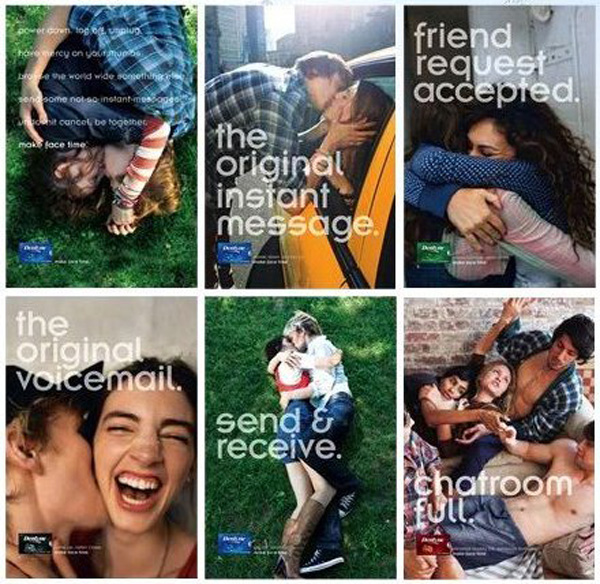I love this ad campaign. A simple idea, well executed. I ask a deceptively simple question: why is it so good?

Dentyne’s Make Face Time Campaign, by McCann Worldwide
Designers are key players in the world of advertising. It’s where many of us make all our money. The giants of our field all won major battles in that arena: Paul Rand, Saul Bass, Tibor Kalman, to name a few. Though I would not presume to place myself in such august company, I have worked for commercial firms and wrestled with advertising work, branding, and experience design in a corporate setting. I’d love to say that I could come up with something as good as McCann’s “Face Time” campaign. But how would I do it?
My design approach is, traditionally, to let the content speak for itself. If I understand the material, then communicating it to an audience through whatever medium I’m working in becomes almost a transparent process; the job sometimes feels like it’s flowing out of me. But frequently in the corporate advertising world, there is no content, in the traditional sense. There is no script, as in theater or film; there are no curators, filling volumes with text about artifacts or ideas. There is only the product, and the company that makes it. Frequently, the folks from the company are looking to the design world to define and shape the substance of the experience. They understand who their target audience is, and all about their brand and product, but look to designers to craft the messages.
It’s not a step I’m accustomed to. I understand, at an elementary level, the message is that the product/service is the best and people should purchase it. But ads with copy like, “WE ARE AWESOME,” or “BUY OUR STUFF BECAUSE IT’S THE BEST EVER” really do not make it to the public eye anymore. Clients expect more from someone who claims to be a hotshot designer–and rightly so. Advertising is a competitive and subtle world; there are wonderful ad campaigns and brand experiences out there. I know them when I see them, and I admire the specificity of the message. So where does that message come from?
In my readings and research, I recently came across this quote.
The new medium of brand experience is now people, not television.
– David Dernie, In Exhibition Design
In one phrase, David Dernie both encapsulated and completed my unformed thoughts about what it means to, as the oft touted phrase goes, “build a brand experience.” For me, it goes beyond television, though it certainly applies. The thing I respond to in ad in any medium is how the people in them feel. The more specific the ad hones in on that feeling, the more effective it is.
Consider this commercial, long considered to be a watershed in the world of automobile advertising:
(For more about this ad, and the Nick Drake book that talks about it, see John’s comment below.)
The ad speaks volumes, and not just because of Nick Drake’s marvelous “Pink Moon.” The ad is incredibly specific about the product and the people who use it. The look the young man in the back seat gives the young woman as she silently watches the night sky fly by, wind in her hair; the flash of the backup light; almost iconic images. The viewer instantly understands what kind of party the young foursome is pulling up to–and why they choose to pull away. When viewed through the lens of Dernie’s statement, the reason for the ad’s success becomes obvious.
In this statement I find a key, also, to understanding why I get that feeling of the medium becoming transparent. When the story is strong, the tricks and skills needed to manipulate the medium fall away as the audience folds into the experience. Listening to Nick Drake for the first time, one rarely wonders what kind of tape it was recorded on, or what Drake’s tuning on the guitar is, or even how skillful a player he is; one listens to the song. Likewise with any good design experience; both for the viewer and the creator, the problems of the medium are all smoothed away. Television and film, in its best moments, no longer merely fascinate us with what they can do; skillful camera work, direction, scripting, combined with the audience’s comfort level with receiving information in that form, have made the television a frictionless conduit for story.
This touches on McLuhan’s signature axiom, of course, of the medium being the message – and might go a long way to refuting it. What happens to a medium when both public and designer are so familiar with it that its novelty, and all the tricks it can be made to do, has worn off? In the past decade, we have seen this happen. The internet used to be a place about itself; merely to have a website or be “be online” was enough of a statement. No longer; we are all so familiar with the medium that we can now push it out of the way and receive the messages.
So what makes an ad good? When approaching my next project, I will pull Dernie’s lens from my pocket and look through it for the people within it. They, after all, are the touchstone for understanding the brand experience. The closer I can get to communicating the emotions, the more specific I can be about them, the more successful the ad.
